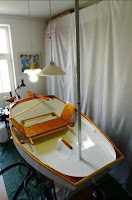 The Navy Days are on in Portsmouth this weekend, and of course we went and gasped at the antics of the helicopters of the Black Cats team, admired the Marines as they put down pirates and gawped at the new Type 45 frigates (which are actually almost as big as one of the old Dreadnought battleships, I was surprised to discover).
The Navy Days are on in Portsmouth this weekend, and of course we went and gasped at the antics of the helicopters of the Black Cats team, admired the Marines as they put down pirates and gawped at the new Type 45 frigates (which are actually almost as big as one of the old Dreadnought battleships, I was surprised to discover).But for me the highlight of the trip was to discover Charles II's Royal Barge in the museum. Built about 1670, it is eight oared (four a side) and slim for her length with a fine entry. She is clearly built for speed rather than vulgar display, like the barges of the Georges which have so much gold leaf they should have turned turtle and sunk the instant they were launched.
 The seat at the back is painted with an image of Britannia, with the face of Charles's French mistress, the Duchess of Portsmouth. Can you imagine what the Daily Mail would make of that today?
The seat at the back is painted with an image of Britannia, with the face of Charles's French mistress, the Duchess of Portsmouth. Can you imagine what the Daily Mail would make of that today?The boat returned to the national stage in 1806 when it was used to bring Nelson's body from Greenwich to London for his state funeral. This is a model of the boat on that occasion, complete with black canopy.
But the other highlight was the Airfix stand, where you could make up a kit on the spot, for free! I assembled HMS Cumberland. It was the first time I had done a plastic kit since my chum Phil and I used to build warships and cut them down to the waterline, fighting naval battles on the living room carpet.

































